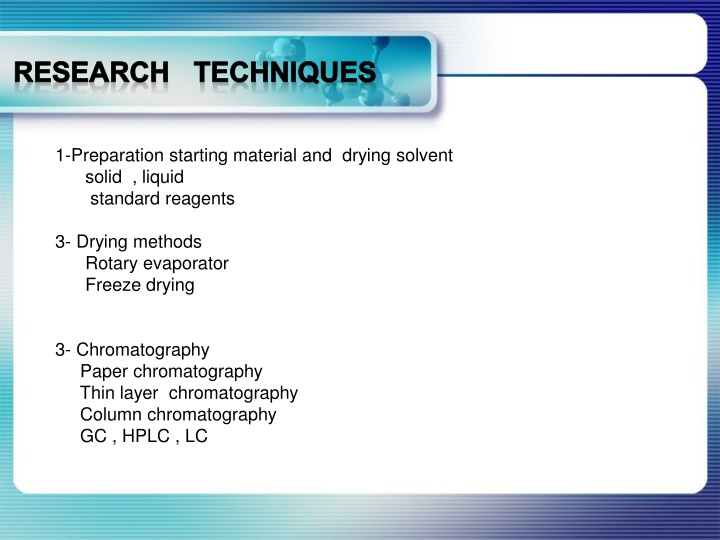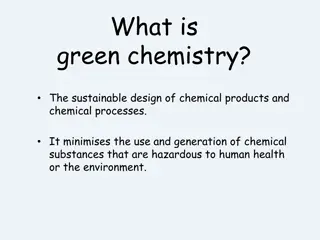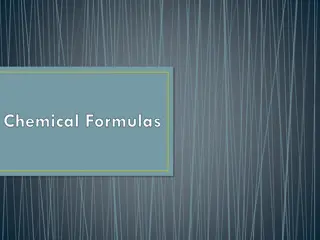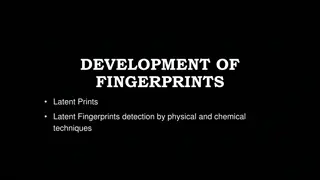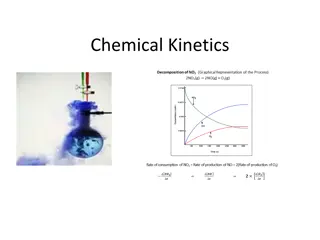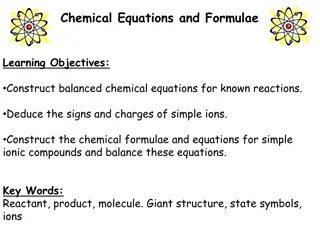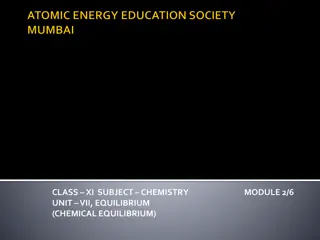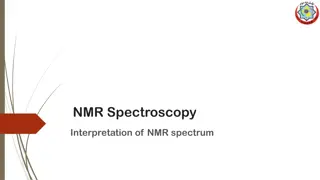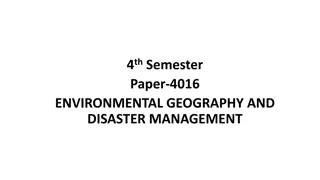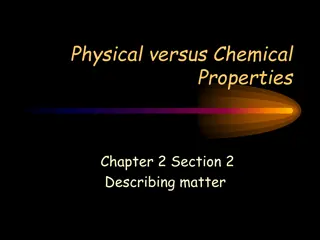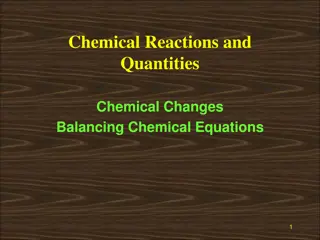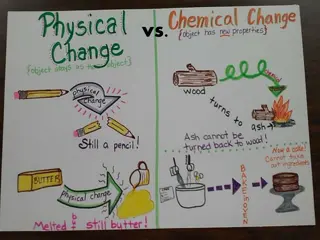Essential Techniques in Chemical Research
Learn about key research techniques in chemistry including preparation methods, drying techniques, chromatography, spectroscopic techniques, and specific solvents used. Understand the importance of starting material preparation, drying reagents such as calcium chloride and molecular sieves, and how to dry solvents like THF, DCM, Acetonitrile, and Methanol effectively.
Download Presentation

Please find below an Image/Link to download the presentation.
The content on the website is provided AS IS for your information and personal use only. It may not be sold, licensed, or shared on other websites without obtaining consent from the author.If you encounter any issues during the download, it is possible that the publisher has removed the file from their server.
You are allowed to download the files provided on this website for personal or commercial use, subject to the condition that they are used lawfully. All files are the property of their respective owners.
The content on the website is provided AS IS for your information and personal use only. It may not be sold, licensed, or shared on other websites without obtaining consent from the author.
E N D
Presentation Transcript
RESEARCH TECHNIQUES 1-Preparation starting material and drying solvent solid , liquid standard reagents 3- Drying methods Rotary evaporator Freeze drying 3- Chromatography Paper chromatography Thin layer chromatography Column chromatography GC , HPLC , LC
4-Spectroscopic technique FTIR ( liquid , gas , solid ) Uv- Visible ( identification , kinetic , concentration ) 5- Mass spectra Hard ionization ( EI) soft Ionization (ESI) GC-Mass , HPLC- Mass Direct insertion probe www.themegallery.com
Preparation starting material Solid sample Test ( melting point , TLC ) Purification ( recrystalization , distillation under vacuum ) Liquid sample test ( boiling point , TLC ) distillation , extraction , Solvents drying agents removing water from solvent www.themegallery.com
Drying reagents Commonly used drying are calcium chloride (CaCl2), sodium sulfate (Na2SO4) calcium sulfate (CaSO4, also known as Drierite) and magnesium sulfate (MgSO4), all in their anhydrous Calcium chloride (n=6) is a very good drying agent for a broad variety of solvents but is generally not compatible with hydroxy (alcohol, phenol), amino (amine, amide) and carbonyl (acid, ketone, ester) Magnesium sulfate (n=7) is a slightly acidic drying agent. It works well in solvents like diethyl ether, but not as well for ethyl acetate. It is a fast drying agent, in part because it comes as a fine powder with a large surface area. Sodium sulfate (n=10) has a very high capacity and is mainly used for very wet solutions Molecular sieves are alumino silicates with a three-dimensional network with different pore sizes (3-5 ). They have to be activated prior use and also can be regenerated at higher temperatures (~180oC - 260oC, 1-2 hours).
Specific solvents THF (Tetrahydrofuran): distilled from sodium benzophenone ketyl. Add sodium wire and benzophenone to a volume of THF (pre-dried over calcium hydride or 4A molecular sieves), heat at reflux/under nitrogen for several hours until the solvent turns deep blue in colour. This indicates the solvent is dry, and you can distill off the volume you require. With time (weeks-maybe months if used correctly) the still will turn orange, this indicates that it is time to make a new one! DCM (Dichloromethane): pre-dry over calcium hydride, then distil over calcium hydride... unfortunately no colorimetric indicator to tell you when the solvent is dry. MeCN (Acetonitrile): pre-dry by shaking with type 4A molecular sieves, the distil over calcium hydride. Dried acetonitrile can be stored over 4A molecular sieves. Methanol: For most purposes, drying over 3A molecular sieves overnight followed by distillation is sufficient. Alternatively, the methanol can be dried from magnesium methoxide. Magnesium turnings (5 g) and iodine (0.5 g) are refluxed in a small (50-100 mL) quantity of dry methanol (from a previous batch) until all of the magnesium has reacted. The mixture is diluted (up to 1 L) with reagent grade methanol, refluxed for 2-3 hours then distilled under nitrogen. DMF (N,N-dimethylformamide): Decomposes slowly at room temperature and more rapidly at reflux, releasing dimethylamine and carbon monoxide. This decomposition is catalysed by acidic and basic impurities, and standing DMF for several hours at room temperature with basic drying agents such as calcium hydride or sodium hydroxide leads to noticeable decomposition. Dry DMF can be prepared by drying overnight over barium oxide or 4A molecular sieves, followed by decantation of the drying agent and vacuum distillation (~20 mmHg is a sufficient vacuum to lower the boiling point over DMF to a reasonable value). Dry DMF can be stored over 4A molecular sieves.
Drying reagents Class of Compounds Recommended Drying Agent Alkane, alkyl halides MgSO4, CaCl2, CaSO4, H2SO4, P4O10 MgSO4, CaCl2, CaSO4,P4O10, Na- metal Aromatic hydrocarbons, ethers Aldehydes, ketones, esters Na2SO4, MgSO4, K2CO3, CaSO4 Alcohols MgSO4, K2CO3, CaSO4, CaO, BaO Amines KOH, K2CO3 Acidic compounds Na2SO4, MgSO4, CaSO4 The drying agent is only working if it is still anhydrous
After Drying Wet solution www.themegallery.com
Drying methods Type of materials sources 1- Extraction materials ( natural compounds ) light oil Terpene oil alkaloids steroids Falvonoids phenol and poly phenol gum ( resin ) 2- preparation materials ( products of organic or inorganic reaction )
Many criteria affect the choice of a drying method during recovery efforts. Among these are: * Ability to appropriately stabilize the environment in order to begin recovery efforts * Scale of damage and number of items affected Best drying method depending on type, format, and volume of material various drying methods Air drying Rotary evaporate * Freezer Drying * Dehumidification drying www.themegallery.com
Air drying Air-drying must take place in a cool, dry place Air-drying rooms should have the capacity to maintain a constant relative humidity of 25 -35% (or at least below 50%) and a temperature of between 50 and 65 degrees F Air circulation should be constant, and may be aided by the use of portable fans Dehumidifiers may be used but must be maintained daily and will only work in smaller, enclosed spaces Air-dry materials indoors if possible
Rotary evaporator www.themegallery.com
Freeze drying (Lyophilization ) Freeze drying is a complex operation where the solvent (usually water) is removed from the product by sublimation. Sublimation occurs when a frozen liquid goes directly to the gaseous state without passing through the liquid phase. This direct phase transfer ice - water vapor is a function of pressure and ice temperature which can be delineated by the phase diagram of water: www.themegallery.com
Lyophilization or freeze drying is a process in which water is frozen, followed by its removal from the sample. initially by sublimation (primary drying) and then by desorption (secondary drying). Freezedrying is a process of drying in which water is sublimed from the product after it is frozen . It is a drying process applicable to manufacture of certain pharmaceuticals and biologicals that are thermolabile or otherwise unstable in aqueous solutions for prolonged storage periods, but that are stable in the dry state. The term lyophilization describes a process to produce a product that loves the dry state www.themegallery.com
Lyophilization is performed at temperature and pressure conditions below the triple point, to enable sublimation of ice. The entire process is performed at low temperature and pressure, hence is suited for drying of thermolabile compounds. Steps involved in lyophilization start from sample preparation followed by freezing, primary drying and secondary drying, to obtain the final dried product with desired moisture content .The concentration gradient of water vapor between the drying front and condenser is the driving force for removal of water during lyophilization www.themegallery.com
APPLICATIONS Pharmaceutical and biotechnology Food Industry Technological Industry In chemical synthesis, products are often freeze dried to make them more stable, or easier to dissolve in water for subsequent use. In bio separations, freeze-drying can be used also as a late-stage purification procedure, because it can effectively remove solvents. Furthermore, it is capable of concentrating substances with low molecular weights that are too small to be removed by a filtration membrane www.themegallery.com
